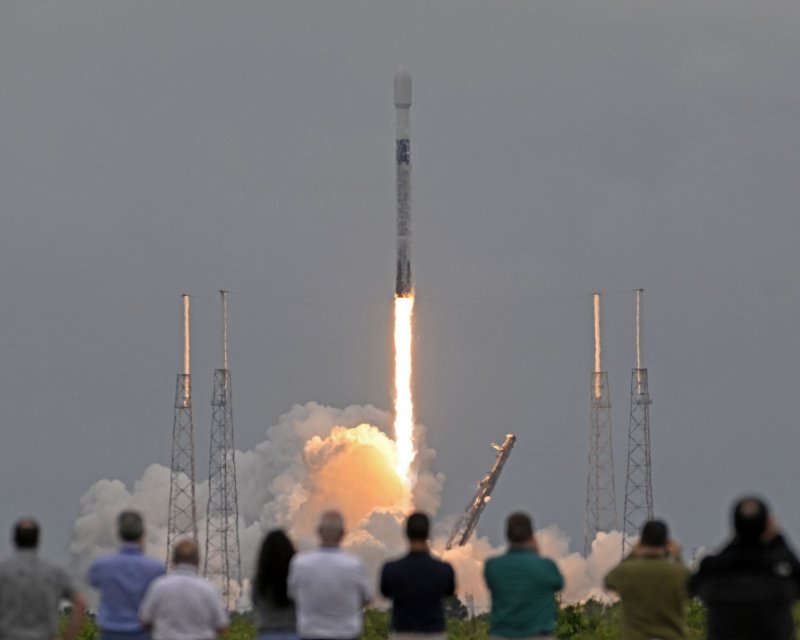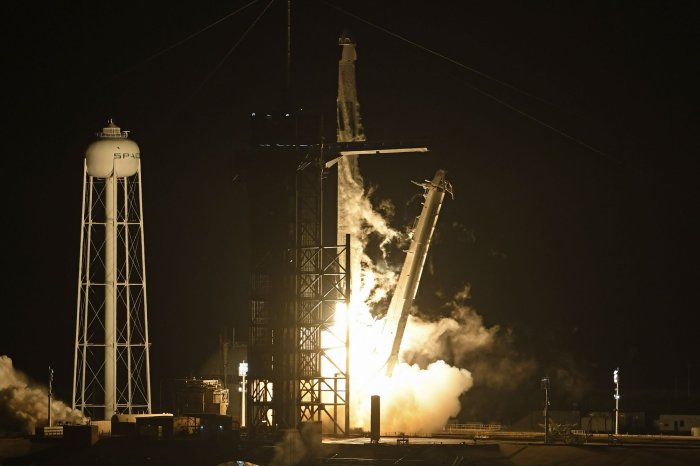1 of 9 | SpaceX on Friday from Complex 40 at Cape Canaveral Space Force Station, Florida, launched the Transporter 4 payload, which consists of multiple nanosatellites for both commercial and government customers. Photo by Joe Marino/UPI |
License Photo
ORLANDO, Fla., April 1 (UPI) -- SpaceX launched its 12th rocket of the year Friday afternoon, in spite of gloomy weather.
The two-stage Falcon 9 rocket blasted off on time at 12:25 p.m. EDT from Space Launch Complex 40 Cape Canaveral Space Force Station, Fla., carrying dozens of small satellites into space as part of the company's fourth dedicated rideshare mission.
About 9 minutes after the rocket launched, the first stage touched down on the deck of SpaceX's drone ship, "Just Read the Instructions" following a series of engine burns designed to slow the rocket down.
"Touchdown! We have successful landing of the first stage," Youmei Zhou, a propulsion engineer at SpaceX said during the launch broadcast.
The mission completed release of satellites from a range of rideshare customers around 1:50 p.m. EDT.
Space Force weather officials initially predicted a 30% chance that the mission will get off the ground, citing cumulus and thick clouds and charged electric fields in the atmosphere as potential issues, however, the weather outlook improved enough for the rocket to get off the ground.
The mission, called Transporter-4, is SpaceX's fourth dedicated rideshare mission, which allows multiple customers to share the expense of sending payloads to space.
SpaceX first announced its Transporter rideshare program in 2019, offering small satellite operators an opportunity to launch their spacecraft for a combined price of $1 million per launch.
The company has launched an average of two Transporter missions a year, but the success of the program has led to suggestions that the launch rate could be doubled.
Friday's mission flew on a used Falcon 9 rocket, designated B1061, that has had six previous successful launches and landings under its belt, with this flight bringing the total up to seven.
The first stage booster made its debut in 2020, when it launched the Crew-1 astronaut mission for NASA.
Subsequent payloads have included two other Dragon spacecraft -- Crew-2 and CRS-23 -- as well as a communications satellite for Sirius-XM, an X-ray satellite for NASA and a batch of SpaceX's own Starlink satellites.
Tucked inside the Falcon's 5.2-meter-wide payload fairing was a total of 40 small satellites that deployed over a period of 90 minutes.
"On this flight are 40 spacecraft, including CubeSats, microsats, picosats, non-deploying hosted payloads and an orbital transfer vehicle carrying spacecraft to be deployed at a later time," Zhou said during the broadcast.
Among the payloads are two prototype satellites for Omnispace that will be the blueprint for a new constellation designed to provide 5G satellite communications to people on Earth.
Also onboard are five small Earth-observation satellites for Satellogic. Each satellite will be able to provide more capable cameras, radios, sensors and computers than their predecessors. SpaceX's previous Transporter mission, which launched in January, also included five small Earth-observation satellites for Satellogic.
SPACELUST will launch a set of seven cubesats, outfitted with a special ion propulsion system, that will enable them to maneuver to a different orbit.
A portion of those satellites, called Kleos satellites, are designed to conduct intelligence and observational studies that can be used by government and commercial organizations.
One of the first satellites deployed was a German satellite designed to conduct environmental mapping and analysis. As the largest satellite among the cargo, the Environmental Mapping and Analysis Program (EnMAP) satellite will monitor and characterize Earth's environment on a global scale.
Once it's operational, EnMAP will be able to provide data to help scientists address issues associated with climate change.
The SpaceX Falcon 9 rocket launches NASA's third crew to the International Space Station at 9:03 p.m. November 10 from the Kennedy Space Center in Florida. Photo by Joe Marino/UPI |
License Photo
















